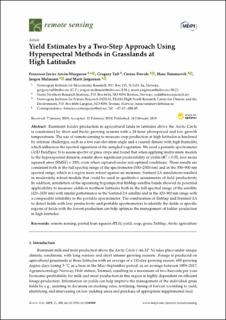| dc.contributor.author | Murguzur, Francisco Javier Ancin | |
| dc.contributor.author | Taff, Gregory | |
| dc.contributor.author | Davids, Corine | |
| dc.contributor.author | Tømmervik, Hans | |
| dc.contributor.author | Mølmann, Jørgen | |
| dc.contributor.author | Jørgensen, Marit | |
| dc.date.accessioned | 2020-02-07T11:03:15Z | |
| dc.date.available | 2020-02-07T11:03:15Z | |
| dc.date.created | 2019-02-18T10:45:00Z | |
| dc.date.issued | 2019 | |
| dc.identifier.issn | 2072-4292 | |
| dc.identifier.uri | http://hdl.handle.net/11250/2640340 | |
| dc.description.abstract | Ruminant fodder production in agricultural lands in latitudes above the Arctic Circle is constrained by short and hectic growing seasons with a 24-hour photoperiod and low growth temperatures. The use of remote sensing to measure crop production at high latitudes is hindered by intrinsic challenges, such as a low sun elevation angle and a coastal climate with high humidity, which influences the spectral signatures of the sampled vegetation. We used a portable spectrometer (ASD FieldSpec 3) to assess spectra of grass crops and found that when applying multivariate models to the hyperspectral datasets, results show significant predictability of yields (R2 > 0.55, root mean squared error (RMSE) < 180), even when captured under sub-optimal conditions. These results are consistent both in the full spectral range of the spectrometer (350–2500 nm) and in the 350–900 nm spectral range, which is a region more robust against air moisture. Sentinel-2A simulations resulted in moderately robust models that could be used in qualitative assessments of field productivity. In addition, simulation of the upcoming hyperspectral EnMap satellite bands showed its potential applicability to measure yields in northern latitudes both in the full spectral range of the satellite (420–2450 nm) with similar performance as the Sentinel-2A satellite and in the 420–900 nm range with a comparable reliability to the portable spectrometer. The combination of EnMap and Sentinel-2A to detect fields with low productivity and portable spectrometers to identify the fields or specific regions of fields with the lowest production can help optimize the management of fodder production in high latitudes. | |
| dc.description.abstract | Yield Estimates by a Two-Step Approach Using Hyperspectral Methods in Grasslands at High Latitudes | |
| dc.language.iso | eng | |
| dc.rights | CC BY 4.0 | |
| dc.rights.uri | https://creativecommons.org/licenses/by/4.0/deed.no | |
| dc.subject | Fjernmåling | |
| dc.subject | Remote sensing | |
| dc.subject | Avling | |
| dc.subject | Yield | |
| dc.subject | Korndyrking | |
| dc.subject | Cereal cropping | |
| dc.title | Yield Estimates by a Two-Step Approach Using Hyperspectral Methods in Grasslands at High Latitudes | |
| dc.type | Peer reviewed | |
| dc.type | Journal article | |
| dc.description.version | publishedVersion | |
| cristin.unitcode | 6002,1,0,0 | |
| cristin.unitname | Norut Northern Research Institute AS, teknologi | |
| cristin.ispublished | true | |
| cristin.fulltext | original | |
| cristin.qualitycode | 1 | |
| dc.identifier.doi | doi.org/10.3390/rs11040400 | |
| dc.identifier.cristin | 1678184 | |
| dc.source.journal | Remote Sensing | |
| dc.relation.project | Framsenteret: 362208 | |
| dc.relation.project | Framsenteret: 362239 | |
| dc.relation.project | Norges forskningsråd: 244251 | |
| dc.relation.project | Andre: PL12-0095 (Polish-Norwegian Research Programme) | |
| dc.subject.nsi | VDP::Landbruksteknologi: 916 | |
| dc.subject.nsi | VDP::Agricultural technology: 916 | |

